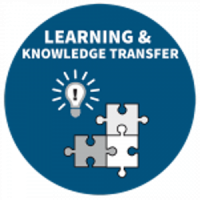Complex, Meidoornkade 22
3992 AE Houten
0343 528 040
3992 AE Houten
0343 528 040

Teams that want to achieve a sustainable outcome need to learn in order to adapt to the dynamic world in which information and interdependencies constantly change. Collective learning, transferring knowledge about dependencies and the root cause of problems, increases the collective ability to anticipate to future events.
The success strategy: Anticipate by learning together. We share and apply our knowledge and experience into our daily practice in order to better anticipate to future challenges and situations. We can discuss this factor using the following success markers: Improve daily work, Anticipate, Root cause, Knowledge transfer and Learn together

Complete your tasks and meetings with three simple quiestions:
Focus on small adjustments with a large effect.
Log the answers. Evaluate this log after 10 days and find a thinking pattern that needs adjustment.
Evaluate team activities in a 10 minute break-out:
Focus on:
Use the answers to define easy to implement improvements.

Active learning requires a combined focus on the present and the future in order to anticipate. Most people need a time-out or reflection moment for this state of mind. Others seem to integrate this forward-thinking in their daily work. Some tips:
Translate the answers in behavior or actions with which you prepare yourself for the future.
Stimulate a group focus on external factors and information.
Discusss what-if scenario’s.
Encourage feedback on ‘group think’ in case team members seem to loose their ability to adapt to new information.

Most people struggle to find the underlying cause of their behavior. Often implicit beliefs and values trigger the way we feel, think and behave.
One way method to reflect on your own logic is the SCORE method (by Robert Dilts)
An issue is a difference between expectations and reality.
Analyze causes by asking the WHY question and repeat the why question for the four consecutive answers.

36% of the team members feels that that knowledge transfer is effective. Especially in complex or dynamic environments this seems insufficient. Team members do not understand eachother and a shared meaning is lacking.
Knowledge transfer starts with framing the required knowledge in a given situation and linking this to your previous reference experiences.Questions to trigger this awareness are:
Implement knowledge transfer as a daily practice in team interactions by asking the following questions:
Create a ‘knowlegde map’: who knows what in relation to the short term results or objective?
Share knowledge when team members experience challenging situations.

36% of the team members feels that that knowledge transfer is effective. Especially in complex or dynamic environments this seems insufficient. Team members do not understand eachother and a shared meaning is lacking.
An external focus, on other team members and on the collectieve objective, is a prerequisite for learning together. High stess levels create a narrow focus, so carefully pick the moments to learn together. For instance at the start of a meeting or during a ‘time-out’ with others. Use simple ‘trigger questions’ during meetings:
Major ‘blockers’ for collective learning experiences are:
Intervision meetings
Agile settings: Plan a sprint retrospective including the use of the a2Results® Team app.
Prince2 settings: Lessons learned session
Rien van Leeuwen gaat in op basiscondities voor duurzame verandering.
Aan de hand van praktijk-cases verkennen we de barrières bij het bereiken van duurzame doelen op strategisch, tactisch en operationeel niveau. Denk hierbij aan bestaande structuren en opvattingen, maar ook aan het niet kunnen duiden van negatieve en positieve impact.
We delen onderling de best practices en interventies die anderen activeren. Uiteindelijk draait elke verandering om een andere manier van interactie.
Rien van Leeuwen gaat in op basiscondities voor duurzame verandering.
Aan de hand van praktijk-cases verkennen we de barrières bij het bereiken van duurzame doelen op strategisch, tactisch en operationeel niveau. Denk hierbij aan bestaande structuren en opvattingen, maar ook aan het niet kunnen duiden van negatieve en positieve impact.
We delen onderling de best practices en interventies die anderen activeren. Uiteindelijk draait elke verandering om een andere manier van interactie.